Top News

November 27, 2013 Wu Li Jun of Ryukyu Shimpo
The Okinawa Convention and Visitors Bureau (OCVB) has called upon Okinawa companies to improve their translated materials and public wireless network (WiFi). The bureau aims to enhance the level of hospitality provided for foreign tourists. As of November 26, the Okinawa Prefectural Government had allocated 20 to 30 percent of this year’s budget on two projects of supporting business translation and increasing the provision of WiFi in Okinawa. A bureau spokesperson said, “We need to boost foreign-language support and the wireless network in Okinawa with these projects.”
Beginning in 2012, in the first fiscal year, the bureau completed 64 translations of menus and brochures of restaurants and tourist spots and set up WiFi in 154 locations.
Okinawa Techno Create Co. that received the translation grant, said, “It used to be difficult to explain items of food to foreign tourists. They now understand the menus so their ordering goes smoothly.”
The projects are ongoing to further enhance the satisfaction of foreign tourists. As translation support, companies receive a maximum of 10,000 yen for each job in a certain language. Each company can receive support on three jobs. For the installation of WiFi, the government subsidizes a maximum 30,000 yen for a building. Okinawan companies filed 45 applications for translation support and 32 for installation of WiFi.
Foreign language services recorded the lowest level of satisfaction in the government survey on foreign tourist satisfaction levels carried out in 2012. There were also many requests for WiFi to be set up. Based on the results of the project to date, the bureau is calling for companies to apply for support to promote tourism. The bureau will provide subsidies until February 28 next year. For further details, call the Overseas Project Department of the OCVB on 098 (859) 6130.
(English translation by T&CT, Megumi Chibana and Mark Ealey)
Go to Japanese

November 29, 2013 Ryukyu Shimpo
The shipping of Japanese tiger prawns has begun in Okinawa before entering the month of December. Prawns are popular as year-end gifts.
Staff at the Ginoza Prawn Farm were busy on November 28 picking and boxing the prawns caught in the local outdoor aquafarm. Shipping the prawns starts from September and will end next July.
The farm ships 45 tons of prawns every year and about three tons in December, when many people place orders.
Prawns about 20 centimeters long are one of the most popular products. The president of the farm, Tadashi Kawasaki, said, “We’ve produced some good-quality prawns this year too. I hope many people enjoy eating them.”
(English translation by T&CT, Mark Ealey)
Go to Japanese

Go To Video
November 27, 2013 Ryukyu Shimpo
On November 27, Nago Mayor Susumu Inamine submitted his written statement of opinion to Deputy Governor Yoshihisa Kawakami on the Henoko landfill application received from the Defense Ministry. The mayor opposes the landfill and has asked Okinawa Governor Hirokazu Nakaima to reject the application. The Defense Ministry has presented the landfill application to build the alternative base for U.S. Marine Air Station Futenma in Henoko, Nago to the Okinawa governor.
The deputy governor replied, “We want to go forward reviewing the application taking into account the opinion of the mayor and related organizations and individuals.”
“I have pointed out the legal problems and improper practices in the landfill project. I have received about 2,500 opinions from citizens. I want the governor to take the thoughts of Nago citizens seriously,” the mayor emphasized.
LDP Diet members from Okinawa have gone back on their policy pledge made during the campaign that they would seek to move the Futenma base outside the prefecture. Instead they now accept the relocation to Henoko. The mayor commented, “I think this is embarrassing. It would seem that there has been pressure or something brought to bear on the local LDP chapter. I want the governor to be faithful to his remarks to date.”
(English translation by T&CT, Mark Ealey)
Go to Japanese
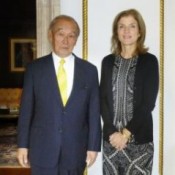
November 30, 2013 Ryukyu Shimpo
Okinawa Governor Hirokazu Nakaima met U.S. Ambassador to Japan Caroline Kennedy for the first time on November 29 in Tokyo. The governor asked the U.S. Ambassador to resolve the Okinawa base issue, saying, “People feel that there is an undue burden of bases in Okinawa. I want you to work towards resolving the issue by taking the feelings of the Okinawan people into consideration.” He asked the ambassador to visit Okinawa, but did not mention the relocation issue of the Futenma base. After the meeting, the governor explained the conversation to reporters at the Diet.
According to an official of the Okinawa Prefectural Government, Kennedy said that she will strive to make progress in resolving the issue of the burden of bases on Okinawa. She said that many people had been working hard to resolve a diverse range of issues. The governor asked the ambassador to go to see Okinawa with her own eyes and listen to what people have to say. She responded that she would like to do this, saying that she wants to hear what Okinawan citizens have to tell her.
The meeting came about due to an invitation from the U.S. Embassy. Susumu Matayoshi, the head of the Executive Office of the Governor, also attended.
The governor is expected to decide whether he will approve or reject the Henoko landfill in December or beyond. In a speech in Tokyo on November 27 Kennedy said that they are committed to proceeding with the relocation of Futenma. She indicated her desire to move the Futenma base within the prefecture in accordance with the Japan-U.S. agreement.
(English translation by T&CT, Mark Ealey)
Go to Japanese
November 29, 2013 Ryukyu Shimpo
Two U.S. military servicemen received prison sentences for robbing and injuring a taxi driver in Okinawa City in 2006. The U.S. government did not provide compensation to the victim for over four years. At first, they said that could not pay the victim if he removed his statement to the Japanese government claiming an out-of-court settlement. They then changed their stance, telling him on November 28 that they would provide the payment. The U.S. government proposed on October 17 that they would pay him about two million yen. The victim’s side signed the document removing the statement. The U.S. government then told the victim on October 30 that they would not go through with the payment procedures if the document abandoned the right to claim to the Japanese government.
Tsutomu Arakaki, the attorney representing the victim, said the U.S. military in Japan told him through the Okinawa Defense Bureau on November 28 that they would go through with payment. The document does not include the statement abandoning the right to claim to the Japanese government. After the U.S. government pays the victim, the Japanese government will pay the remaining compensation based on the Special Action Committee on Okinawa agreement reached in 1996.
Arakaki said, “Now that the U.S. government will pay, we can say that we managed to settle the case. But even so, it is an issue that the U.S. government didn’t pay for such a long time and that they made excessive demands upon the victim.”
The Defense Facilities Environs Improvement Association, an affiliated organization of the Ministry of Defense, provided an interest-free loan to the victim on November 21. This came from the relief loan program for those affected by incidents involving U.S. military personnel.
The court ordered the accused to pay 28 million yen in compensation. The organization provided the amount excluding workers accident compensation that the victim had already received. The U.S. and Japanese governments will pay the organization back for the loan.
(English translation by T&CT, Mark Ealey)
Go to Japanese
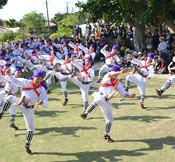
November 21, 2013 Ryukyu Shimpo
On November 20, the Tanadui Festival, which dates back over 600 years and has been designated as an important intangible cultural heritage by the Japanese government, was held at the Yumuchi utaki (or sacred place) on Taketomi Island. Many tourists from outside the island crowded into the Yumuchi utaki and enjoyed performances of traditional dance and comic drama. The locals dedicated the dance for a good harvest to the gods on November 21.
Taketomi residents hold the Tanadui Festival in the hope that planted seeds will grow successfully and for a year of good harvests. This festival held over ten days is the biggest event held on Taketomi Island.
On November 20, the festival opened with a performance in the garden in front of the utaki, a bold display of stick fighting, and Umanusha, which represents the motion of riding a horse. The traditional short comedy drama Kajiko (metal-smith) and the Yuhiki were performed on stage.
(English translation by T&CT, Hitomi Shinzato and Mark Ealey)
Photograph:
Go to Japanese
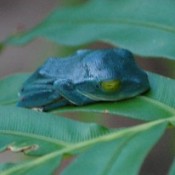
November 27, 2013 Ryukyu Shimpo
Could this blue frog be related to the blue bird of happiness? Akira Oyama, an eco-tour guide of the Ogimi Marugoto Tourism Association, found a blue Okinawan tree frog (Rhacophorus viridis) in the mountains of the northern area of the main island on November 21. According to experts, frogs with blue skin due to abnormal pigmentation are rare. Oyama found the four-centimeter long frog asleep on the grass. “I thought it was an insect or something for a moment, but when I looked closely I realized that it was a frog,” said Oyama.
This species of frog inhabits Okinawa’s main island. Normally, its skin is yellow-green in color. Takeshi Sasaki, a curator of University of the Ryukyus Museum, said, “Very few of these frogs exist because their color is caused by mutation.”
In Bali, Indonesia, blue frogs are also referred to as “the frog of happiness.” “As with the blue bird of happiness, this could mean that happiness will appear in a familiar place for you,” said Oyama with a smile.
(English translation by T&CT, Mark Ealey)
Go to Japanese
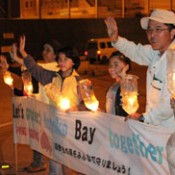
November 25, 2013 Ryukyu Shimpo
As the U.S. and Japanese governments work on moving U.S. Marine Corps Air Station Futenma to the Henoko district in Nago, the “Peace Candle” gathering held on November 24 in protest against the building of a new base marked its tenth year. Every Saturday evening participants light candles in front of Camp Schwab to call for the preservation of the sea off Henoko. Land surveyor Takekiyo Toguchi and his wife Chikako started the gathering and continue to hold it with their children.
The couple prays for world peace, offering “rays of hope” that the governments will give up on building the base.
The gathering started in November 2004. Back then the Toguchis lived with their son Takeryu and newly born twin sisters Kazuki and Wakana in Sedake, which faces Oura Bay where the governments plan to build the base. They started the protest gathering, with like-minded people then taking part to oppose the plan. They stand beside National Route 329, holding a banner written in English and Japanese saying, “Let’s protect our sea of Henoko.” They wave and call to passersby and people involved with the U.S. military.
At the beginning, the couple thought twice about getting their children involved, but then Chikako came to think that they were holding the rally for their children. Hoping that the children would understand what they are doing, the couple continued to stand in protest along the road. The children came to understand.
Kazuki said, “While standing on the roadside protesting, I began to think about why U.S. military bases exist in Okinawa.” Wakana said, “I came to know about the issues of the new base and the Osprey by watching television. I want more people to oppose the plan.” She continued, “I am happy to take part in the rally with my parents.”
Okinawa Governor Hirokazu Nakaima will decide in December or beyond whether or not to grant approval of the application documents to reclaim land off Henoko. Takekiyo said, “We will continue to hold the rally until the governments give up on the plan. I want to bring it to an end in this, its tenth year.”
(English translation by T&CT, Mark Ealey)
Go to Japanese
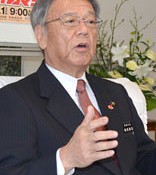
November 21, 2013 Ryukyu Shimpo
The headquarters of the ruling Liberal Democratic Party (LDP) have put pressure on their Okinawa branch to accept the plan to move U.S. Marine Corps Air Station to Henoko in Nago. Referring to this at a press conference on November 20, Naha Mayor Takeshi Onaga said, “It is an extremely unfortunate situation.” He went on to comment that it was commendable that over the past few years all of the Okinawan political parties had been united against the relocation plan and the deployment of the Osprey to Okinawa. Onaga said, “I would like Okinawan people to think carefully about the meaning of this series of events.”
During the Lower House elections of December 2012, Mayor Onaga ran the campaign headquarters for LDP candidate Konosuke Kokuba and others who then had pressure brought to bear on them by the party to renege on their campaign pledges to move the facilities at Futenma out of Okinawa. Onaga said, “For the past year and a half we have been talking about what sort of things they might do, including being told to leave the party.” He said that the latest developments were “not entirely unexpected.”
Onaga said, “In the 68 years since the end of WWII, there has not been another time when the hearts of the Okinawan people were united in such a nonpartisan manner.” On the topic of the Nago mayoral election to be held next January, in reference to the presence of the U.S. military bases having caused such conflict among the Okinawan people, he said, “I sense something absolutely outrageous.” He said, “I want Okinawan people to pay close attention to developments from now, and to ponder over the magnitude of what was has been achieved to date.”
(English translation by T&CT, Lima Tokumori and Mark Ealey)
Go to Japanese

Go To Video
November 21, 2013 Ryukyu Shimpo
The Mayor of Nago has completed his draft statement of opinion on the government plan to relocate U.S. Marine Corps Air Station Futenma to Henoko in Nago. In many as 23 pages of densely formatted text, one by one, the mayor carefully points out the irrational issues in the reclamation project proposed by the central government. His assertions are both logical and convincing, clearly revealing the injustice of the reclamation plan. By rights, if the Okinawa governor takes this seriously, he will not be able to approve the landfill. If the central government cannot provide logical responses to the mayor’s statement of opinion it should do the decent thing and abandon the plan.
Enormous amount of sediment
His written opinion is clear and every assertion is backed by logic. Suggestions referring to the problem of the large amounts of sediment are the most compelling. Huge amount of sediment, the equivalent in volume to 70 buildings the size of the Okinawa Prefectural Office building, will be put into the beautiful sea of Oura Bay and off the coast of Henoko. Moreover, 80 percent of this sediment will be brought from outside the prefecture. Without a doubt the precious ecosystem in the area will be disturbed by invasive alien species in the sediment. In the landfill application, the Defense Ministry merely wrote that they would adopt measures based on the Invasive Alien Species Act.
Who will check for the contamination by foreign organisms in such a large amount of sand as 17 million cubic meters? How will they do this? This is poorly thought out. As the mayor pointed out in his written opinion, there is no mention of a certificate from the supplier for the control of invasive alien species. We can only conclude that the mayor’s statement that it would be almost impossible to prevent the mixture of invasive alien species is correct.
Article 4-2 of the Public Water Body Reclamation Act states that the landfill should not conflict with the laws or plans of the central and local governments on environmental protection. The government plans to designate Yambaru, including the planned reclamation area, as a World Natural Heritage site. In keeping with that, they must take thorough countermeasures to prevent the entry of alien species. Reclaiming an area of sea with mountains of sediment clearly contradicts this, and so the reclamation conflicts with the plan for World Heritage designation.
In its guidelines for the conservation of the natural environment, the Okinawa Prefectural Government classifies Oura Bay as Rank 1. This ranking requires the strictest standards for preserving the environment, so destroying the area flies in the face of the prefectural government’s own guidelines. The central government wrote in its environmental statement that dugongs do not use these waters and that reclamation would have little affect on animal life there. However, results of a central government survey not open to the public indicate that traces of dugongs having fed on seaweed underwater in this area have been confirmed. The government also did not reveal that sea turtles, an endangered species, come ashore on the beaches of Henoko every year. The government said that they would transplant the sea grass beds, which are food for dugongs, to other places.
However, attempts to do this in the past, using both mechanical means and by hand, have failed. The government has also closed their eyes to the fact that living coral covers 40 percent of the reef in Henoko, while usually the extent of cover is less than 10 percent. Nevertheless, the government has stated that the area was not a favorable habitat for coral.
The mayor points out that the government’s position of hiding inconvenient truths was contrary to the basic principles of environmental impact assessment and it is neither democratic nor scientific. He is right on the mark.
Residents’ safety is top priority
Paragraph 4-1 of Article 4 of the Public Water Body Reclamation Act requires the government to take care to prevent disasters and protect the environment. As we mentioned above, the Henoko landfill plan lacks any desire to give due attention to environmental protection. The mayor also suggested in his statement of opinion that the plan lacks concern for disaster prevention.
As the mayor points out, the government and the U.S. military only revealed the deployment of MV-22 Osprey aircraft at the very end of the process of the evaluation report, at a stage when residents could not provide opinion. To start with, the government suggested a flight zone that is trapezoidal in shape as evidence that the aircraft would not fly over residential areas, but it ended up being oval and so the aircraft will fly over residential areas. The bottom-line is that the government hides the truth, so people cannot believe its promises that the aircraft will operate safely. Noise pollution goes without saying. The mayor insists that going ahead with the landfill would jeopardize the performance of the most important responsibility of local government of ensuring the safety and security of residents. This stance is understandable.
Article 4-1 of the Public Water Body Reclamation Act requires the governor not to approve the landfill application if it is not proper and reasonable use of national land. The plans to move the U.S. Marines to Guam and Australia and the relocation of U.S. Marine Air Station Futenma to Henoko lack consistency. Analysts in Japan and the United States have suggested that both governments should consider other options.
Relocating the Futenma base within the prefecture is not “the only viable solution” that the central government refers to it as. This project is not appropriate. We cannot approve it whatever viewpoint is taken.
(English translation by T&CT, Mark Ealey)
Go to Japanese

November 22, 2013 Ryukyu shimpo
Uchinaguchi (Okinawan language) has words that cannot be pronounced using the 50 Japanese syllabary. In this respect, the difficulty of using the Japanese writing system to read Uchinaguchi aloud has limited the spread of the language and passing it on to the next generation. In seeking solutions, Okinawan language researchers have created a special play script using the 50 Japanese syllabary plus 23 more Okinawan characters. Kochinda Junior High School in Yaese Town experimented with the script in their kumiodori class. On November 16 at the Town Hall, the students performed the kumiodori called Migawari chujo, which is set in Yaese Town.
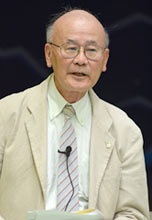
Shinsho Kuniyoshi
Yaese Town Board of Education member Takeshi Kamiya, who is also a
kumiodori actor, had found an easy-to-follow script, which he suggested that the school try with its Okinawan characters. Shinsei Kuniyoshi, of the Tokyo Branch of the Association for Okinawan Languages, wrote the script and Funazu Yoshiaki, a friend of Kuniyoshi, designed the Okinawan characters about 30 years ago.
The students started rehearsing the play in July. At the beginning, they thought that the script with the Japanese syllabary was difficult to understand because it was in hiragana, but in September, Kuniyoshi wrote a new script and visited students to teach them the pronunciation. The new script made all the difference. One of the students said, “It was easy to read.” Another said, “I learned the rhythm of Uchinaguchi.”
Several Okinawan writing systems have been created in the past. In this play’s script, one character represents one sound rather than being expressed by two or even three hiragana characters. Kuniyoshi explained, “It is difficult to understand and memorize lines if you read them using the existing notation. I made it easier for the students to read it aloud.”
At the performance the students proudly delivered their lines entirely in Uchinaguchi. One of them, Yudai Miyagi, said, “Losing Uchinaguchi speakers is a serious problem. We want to pass the language on to the next generation.” The performance included a lecture by Kuniyoshi and a professional dance.
(English translation by T&CT, Megumi Chibana and Mark Ealey)
Go to Japanese











 Webcam(Kokusai Street)
Webcam(Kokusai Street)


